
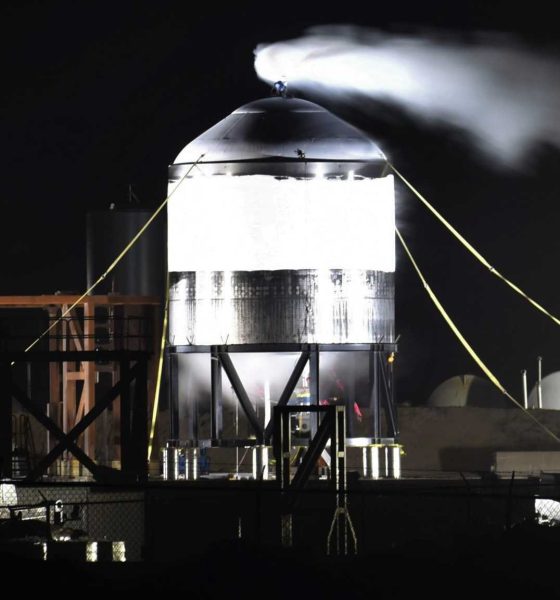
News
SpaceX's latest Starship test was uneventful and that's great news for its flight debut
According to Elon Musk, SpaceX has successfully completed its latest Starship prototype test in a uniquely uneventful fashion, great news for the next-generation rocket’s next steps and first flight tests.
The SpaceX CEO revealed the news some 12 hours after the company wrapped up the Starship tank test at its Boca Chica, Texas facilities. Another excellent example of SpaceX’s preferred process of agile development, the test followed just nine days after the Starship SN01 prototype’s first cryogenic test unexpectedly unearthed a design flaw. SpaceX analyzed the results of Starship SN01’s unintentional launch debut and drew up plans to rapidly repurpose a Starship tank initially destined for the SN02 prototype.
By using existing hardware to test an upgraded iteration of the part that destroyed Starship SN01, SpaceX has now effectively retired the risk posed by that prior failure less than two weeks after it occurred. Elon Musk specifically noted that the former SN02 engine section “passed cryo pressure & engine thrust loads,” confirming that there was more to the exceptionally uneventful evening of March 8th than met the eye. While putting on much less of a show for local observers, this particular boring test is a great sign for the next few steps of SpaceX’s Starship development program.
SN2 (with thrust puck) passed cryo pressure & engine thrust load tests late last night— Elon Musk (@elonmusk) March 9, 2020
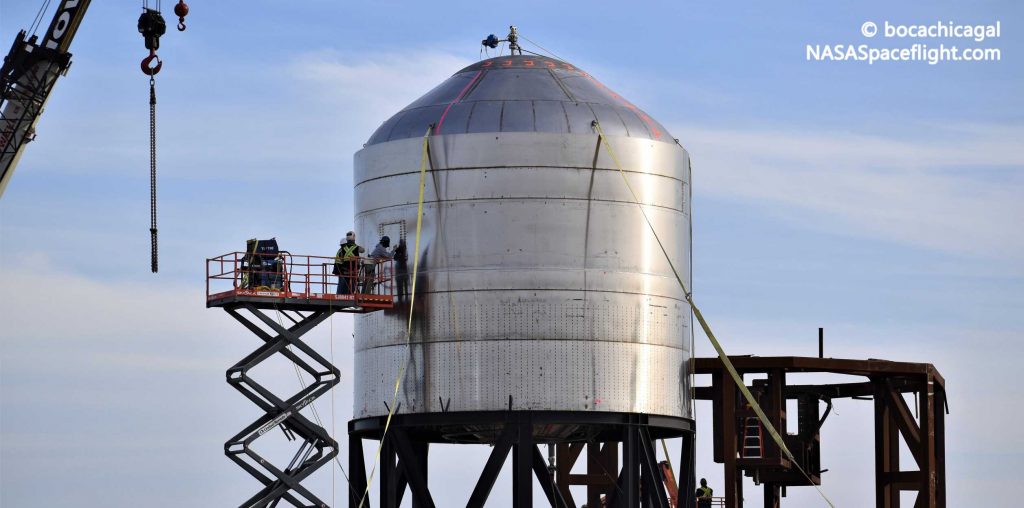
Simply put, despite successfully demonstrating that Starship’s improved “thrust puck” and engine section can survive flight-level tank pressures and the thrust of a Raptor engine, one would be hard-pressed to determine as much by inspecting the prototype that managed the feat. Such a visually uneventful test is a first for SpaceX’s post-Starhopper Starship testing, where “before” and “after” photos typically start with a shiny tank and finish with a well-distributed field of steel shrapnel.
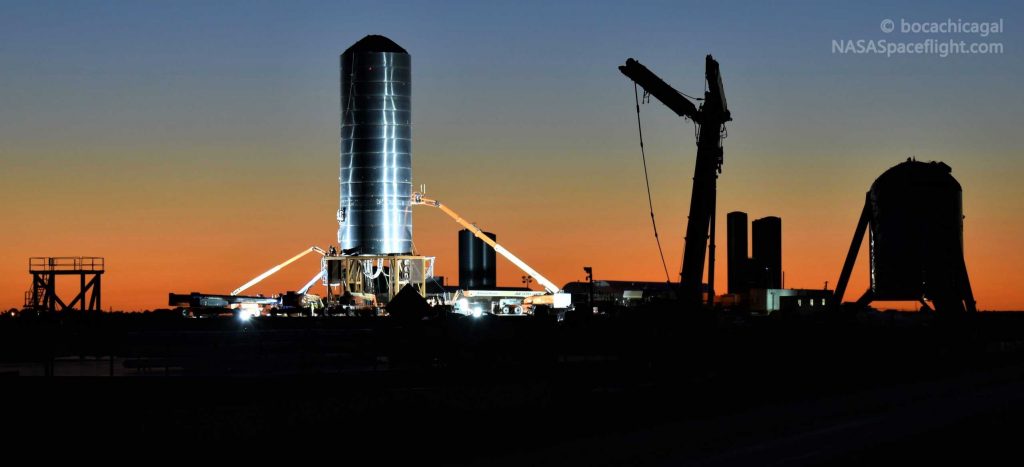
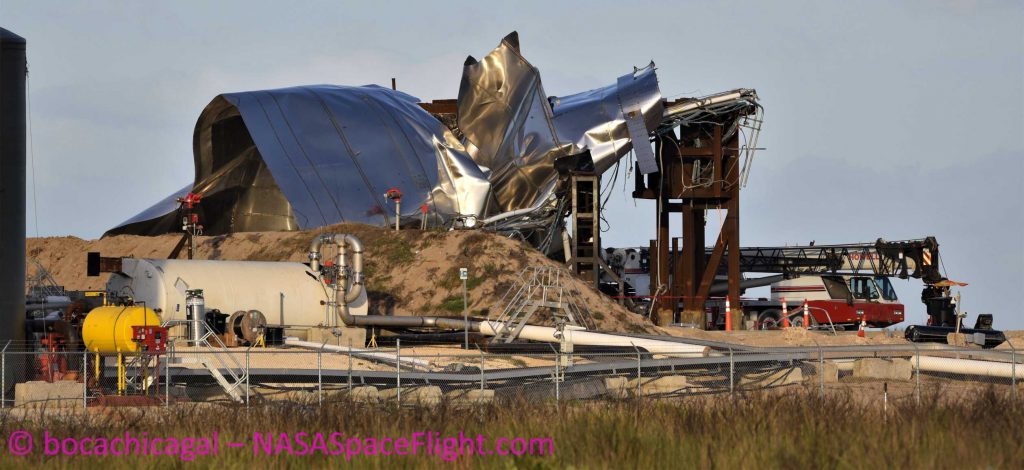
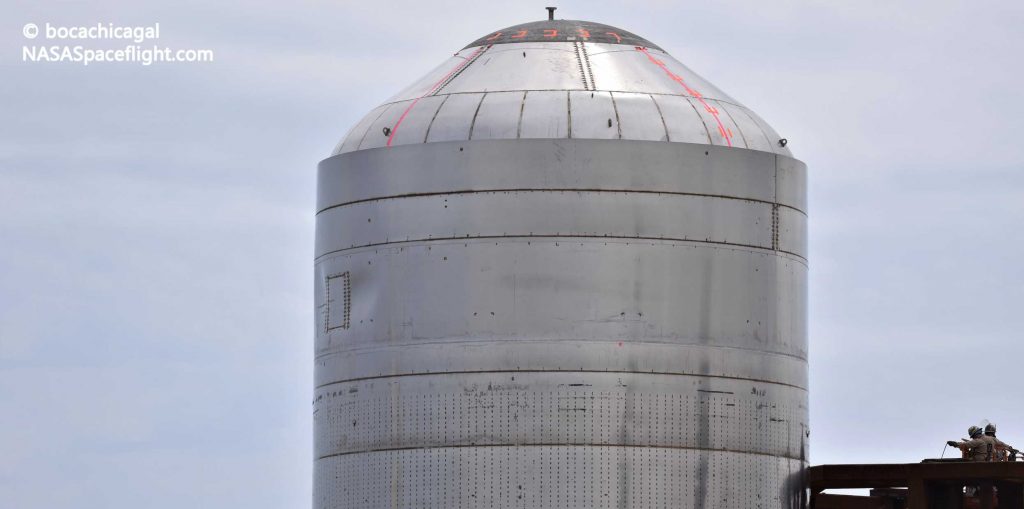
Musk’s description of the test suggests that SpaceX’s intention with the SN02 test tank – built in just two weeks – was to stress it up to (and likely beyond) the pressures and mechanical stresses Starship engine sections will need to survive in flight. In simpler terms, they likely tried to burst the tank by pressurizing it with liquid nitrogen, a supercool cryogenic fluid. It’s unclear exactly how far SpaceX pushed the tank, but it’s safe to say that it went at least as high as past test tanks, meaning 7-8.5 bar or 100-125 psi. At a bare minimum, a test that failed to reach Starship’s minimum flight pressure of 6 bar (90 psi) would be of dubious value for the actual orbital ship.
A step further, SpaceX installed a hydraulic jack underneath the test tank in a bid to simulate the stresses it would experience with a single Raptor engine. Capable of producing approximately 150-200 tons (1500-2000 kN) of thrust, even Raptor is relatively minor compared to the Starship tank’s likely ~500 metric ton (1.1 million lb) mass. Still, the fact that the SN02 test tank survived the combination of a highly pressurized tank and the simulated thrust of a Raptor engine suggests that SpaceX is now ready for a more successful repeat of Starship SN01 testing.
Confirming those suspicions, Musk subsequently revealed that the Starship prototype integrated immediately after the SN02 test tank will likely attempt the first Raptor static fire tests and may even perform short flights further down the road. As always, SpaceX’s testing programs are fluid and likely to change as new results continuously shape the path forward, meaning that Starship SN03 could easily be destroyed during testing. Starship SN04, said by Musk to be the hopeful candidate for “longer [test] flights,” would thus be repurposed to continue SN03’s test campaign — and so on with SN05, SN06, and beyond.
Regardless, as the CEO notes, perhaps the most important aspect of all these rapid-fire tests is that SpaceX is quickly building up an impressive Starship production line. Before, during, and after SN02’s test campaign, SpaceX’s South Texas team has been simultaneously fabricating and stacking new steel rings, bulkheads, and noses for the next few Starship prototypes. As a result, Starship SN03’s tank section could be just a week or two away from complete integration, after which SpaceX will likely transport it to the launch pad to prepare for Raptor static fire testing.
Check out Teslarati’s Marketplace! We offer Tesla accessories, including for the Tesla Cybertruck and Tesla Model 3.

Elon Musk
Elon Musk and Tesla AI Director share insights after empty driver seat Robotaxi rides
The executives’ unoccupied tests hint at the rapid progress of Tesla’s unsupervised Robotaxi efforts.

Tesla CEO Elon Musk and AI Director Ashok Elluswamy celebrated Christmas Eve by sharing personal experiences with Robotaxi vehicles that had no safety monitor or occupant in the driver’s seat. Musk described the system’s “perfect driving” around Austin, while Elluswamy posted video from the back seat, calling it “an amazing experience.”
The executives’ unoccupied tests hint at the rapid progress of Tesla’s unsupervised Robotaxi efforts.
Elon and Ashok’s firsthand Robotaxi insights
Prior to Musk and the Tesla AI Director’s posts, sightings of unmanned Teslas navigating public roads were widely shared on social media. One such vehicle was spotted in Austin, Texas, which Elon Musk acknowleged by stating that “Testing is underway with no occupants in the car.”
Based on his Christmas Eve post, Musk seemed to have tested an unmanned Tesla himself. “A Tesla with no safety monitor in the car and me sitting in the passenger seat took me all around Austin on Sunday with perfect driving,” Musk wrote in his post.
Elluswamy responded with a 2-minute video showing himself in the rear of an unmanned Tesla. The video featured the vehicle’s empty front seats, as well as its smooth handling through real-world traffic. He captioned his video with the words, “It’s an amazing experience!”
Towards Unsupervised operations
During an xAI Hackathon earlier this month, Elon Musk mentioned that Tesla owed be removing Safety Monitors from its Robotaxis in Austin in just three weeks. “Unsupervised is pretty much solved at this point. So there will be Tesla Robotaxis operating in Austin with no one in them. Not even anyone in the passenger seat in about three weeks,” he said. Musk echoed similar estimates at the 2025 Annual Shareholder Meeting and the Q3 2025 earnings call.
Considering the insights that were posted Musk and Elluswamy, it does appear that Tesla is working hard towards operating its Robotaxis with no safety monitors. This is quite impressive considering that the service was launched just earlier this year.
Elon Musk
Starlink passes 9 million active customers just weeks after hitting 8 million
The milestone highlights the accelerating growth of Starlink, which has now been adding over 20,000 new users per day.

SpaceX’s Starlink satellite internet service has continued its rapid global expansion, surpassing 9 million active customers just weeks after crossing the 8 million mark.
The milestone highlights the accelerating growth of Starlink, which has now been adding over 20,000 new users per day.
9 million customers
In a post on X, SpaceX stated that Starlink now serves over 9 million active users across 155 countries, territories, and markets. The company reached 8 million customers in early November, meaning it added roughly 1 million subscribers in under seven weeks, or about 21,275 new users on average per day.
“Starlink is connecting more than 9M active customers with high-speed internet across 155 countries, territories, and many other markets,” Starlink wrote in a post on its official X account. SpaceX President Gwynne Shotwell also celebrated the milestone on X. “A huge thank you to all of our customers and congrats to the Starlink team for such an incredible product,” she wrote.
That growth rate reflects both rising demand for broadband in underserved regions and Starlink’s expanding satellite constellation, which now includes more than 9,000 low-Earth-orbit satellites designed to deliver high-speed, low-latency internet worldwide.
Starlink’s momentum
Starlink’s momentum has been building up. SpaceX reported 4.6 million Starlink customers in December 2024, followed by 7 million by August 2025, and 8 million customers in November. Independent data also suggests Starlink usage is rising sharply, with Cloudflare reporting that global web traffic from Starlink users more than doubled in 2025, as noted in an Insider report.
Starlink’s momentum is increasingly tied to SpaceX’s broader financial outlook. Elon Musk has said the satellite network is “by far” the company’s largest revenue driver, and reports suggest SpaceX may be positioning itself for an initial public offering as soon as next year, with valuations estimated as high as $1.5 trillion. Musk has also suggested in the past that Starlink could have its own IPO in the future.
News
NVIDIA Director of Robotics: Tesla FSD v14 is the first AI to pass the “Physical Turing Test”
After testing FSD v14, Fan stated that his experience with FSD felt magical at first, but it soon started to feel like a routine.

NVIDIA Director of Robotics Jim Fan has praised Tesla’s Full Self-Driving (Supervised) v14 as the first AI to pass what he described as a “Physical Turing Test.”
After testing FSD v14, Fan stated that his experience with FSD felt magical at first, but it soon started to feel like a routine. And just like smartphones today, removing it now would “actively hurt.”
Jim Fan’s hands-on FSD v14 impressions
Fan, a leading researcher in embodied AI who is currently solving Physical AI at NVIDIA and spearheading the company’s Project GR00T initiative, noted that he actually was late to the Tesla game. He was, however, one of the first to try out FSD v14.
“I was very late to own a Tesla but among the earliest to try out FSD v14. It’s perhaps the first time I experience an AI that passes the Physical Turing Test: after a long day at work, you press a button, lay back, and couldn’t tell if a neural net or a human drove you home,” Fan wrote in a post on X.
Fan added: “Despite knowing exactly how robot learning works, I still find it magical watching the steering wheel turn by itself. First it feels surreal, next it becomes routine. Then, like the smartphone, taking it away actively hurts. This is how humanity gets rewired and glued to god-like technologies.”
The Physical Turing Test
The original Turing Test was conceived by Alan Turing in 1950, and it was aimed at determining if a machine could exhibit behavior that is equivalent to or indistinguishable from a human. By focusing on text-based conversations, the original Turing Test set a high bar for natural language processing and machine learning.
This test has been passed by today’s large language models. However, the capability to converse in a humanlike manner is a completely different challenge from performing real-world problem-solving or physical interactions. Thus, Fan introduced the Physical Turing Test, which challenges AI systems to demonstrate intelligence through physical actions.
Based on Fan’s comments, Tesla has demonstrated these intelligent physical actions with FSD v14. Elon Musk agreed with the NVIDIA executive, stating in a post on X that with FSD v14, “you can sense the sentience maturing.” Musk also praised Tesla AI, calling it the best “real-world AI” today.








